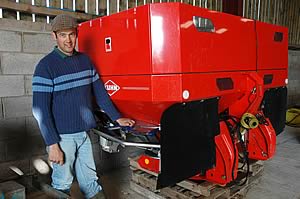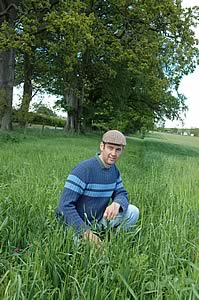 |
|||||||||
|
|||||||||||||||||||
Kuhn Spreader Hits the Fertiliser Target 04/08/06 Accurate fertiliser spreading has long been a priority for Cumbrian farmers Mark and Charlie Jones, but entry of Low Plains Farm, Calthwaite, into a Countryside Stewardship scheme last autumn has placed even greater importance on this job.
Farming 400 acres of arable crops on their Eden Valley unit, the Jones’ have always insisted on buying top quality fertiliser and spreading it with a reliable and accurate machine. This ensures the best results from their cereals and potatoes enterprises, and makes the most efficient use of increasingly costly fertiliser inputs. Within the Countryside Stewardship Level 1 requirements, fertiliser (and sprays) cannot be spread on the buffer strips that now exist in varying widths around the farm, and hence there is now a greater focus on the border spreading capability of their spreader. “We operated a Kuhn MDS 1132 spreader before and were very happy with its performance overall,” said Charlie Jones. “This machine could be set for border spreading, but this would involve getting off the tractor and making adjustments to the vanes on the discs. Given the increased frequency of border spreading with the introduction of buffer strips, we decided to look at an automated system that would ultimately save us a lot of time.”
Kuhn offers a number of border spreading options on its machines, including automated cab-operated facilities that can be retrofitted to MDS spreaders. This system is called Telimat and comprises an hydraulically operated arm supporting an arrangement of stainless steel deflector fins, which – when positioned in the path of the fertiliser – accurately controls its direction and distribution at the field margins. The system is operated by a single-acting ram, which pushes the unit into position, and a spring that lifts it out of position. Calibration involves two key adjustments, including the distance of the fins from the spreading discs (set according to fertiliser type), and the angle of the fins within the unit (set according to working width). The Telimat system operates on Kuhn’s MDS spreaders and also on the new Axis machine launched this season. “We looked at the option of having the Telimat system fitted to our MDS 1132 spreader but decided in the end that it would be as cost effective to buy one of the new Axis spreaders with the system included,” adds Charlie Jones. ”The Axis is the next generation spreader from Kuhn, and it retains all the features that we liked on the MDS, including its simplicity and ease of use – and of course the accuracy.” Although many of the features on the Axis remain from the MDS range, the heart of the machine – its distribution system – is state-of-the-art new technology. Axis has the ability to maintain consistently accurate spread patterns automatically at varying forward speeds and/or application rates and can also achieve an unprecedented maximum mass flow rate of up to 500 kg/minute – which may well be relevant to the Jones’ when spreading on their potato ground. Both of these key attributes are the result of patented distribution technology, known as Coaxial Distribution Adjustment (CDA), and are the main reasons why the Axis is being positioned as a new generation of fertiliser spreader offering tangible benefits within progressive agriculture, including precision farming applications. The Telimat system offers similar accuracy to the standard border spreading system on Kuhn’s MDS spreaders. As with Kuhn’s other border spreading systems, calibration charts for Telimat are designed for settings in the Optimum Yield Position (where some fertiliser will go over the boundary edge) or the Optimum Environment Position (where no fertiliser goes over the boundary and a yield penalty is accepted). In the Jones’ case, the Optimum Environment Settings will apply, and they can have full confidence in their machine’s ability to meet their stewardship obligations for fertiliser spreading. It goes without saying that they will also continue to make best use of inputs, and their winter wheat, barley and oats crops – the latter being grown on contract for Quaker – will continue to achieve the very best quality output. “We won’t see the final results from our Axis spreader until we harvest the crops in the summer,” concludes Charlie Jones, “but we’ve certainly no complaints at this stage. “The automatic border spreading systems has been effective and has saved us a lot of time, and our crops all look very even and application rates have been accurate.” Spreading at Low Plains is currently done to 21 metres, but the plan is to increase the tramlines to 24 metres from next season, a move that will be well within the capabilities of the Axis spreader.
| |||||||||||||||||||

|
|
||||||||||||||||||
| home | agri-services | pedigree
pen | news | dairy | beef | machinery quota | property | organisations | site map |
|||||||||||||||||||


